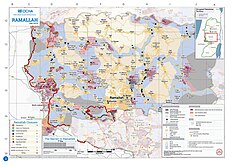Ramallah and Al-Bireh Governorate
The Ramallah and al-Bireh Governorate (Arabic: محافظة رام الله والبيرة Muḥāfaẓat Rām Allāh wa l Bīra) is one of 16 governorates of Palestine. It covers a large part of the central West Bank, on the northern border of the Jerusalem Governorate. Its district capital or muhfaza (seat) is the city of al-Bireh.[2][3]
Ramallah and Al-Bireh Governorate | |
|---|---|
 | |
 | |
 2018 United Nations map of the area, showing the West Bank | |
| Coordinates: 31°55′59″N 35°12′18″E / 31.933°N 35.205°E | |
| Country | |
| Area | |
| • Total | 844 km2 (326 sq mi) |
| Population (2017 Census)[1] | |
| • Total | 328,861 |
| This figure excludes the Israeli West Bank Settlements | |
| ISO 3166 code | PS-RBH |
According to the Palestinian Central Bureau of Statistics (PCBS), the district had a population of 279,730 in 2007.[4]
Ramallah and Al-Bireh Governorate (Arabic: محافظة رام الله والبيرة) is an administrative division based on the fact that the two sister cities Ramallah and Al-Bireh are so adjacent that they appear as one city. This governorate is one of the sixteen governorates under the Palestinian Authority. The governorate center is located in the city of Al-Bireh and the governor is Dr. Laila Ghanem (Arabic: ليلى غنام). It is the closest city in the West Bank to the Jerusalem Governorate. According to statistics,[5] the population of the governorate is 590,401 people.
Cities and villages
changeAccording to PCBS, the governorate has 78 localities, including s, in its jurisdiction. 13 localities have the status of municipality.
Cities
changeRefugee camps
changeMunicipalities
changePlaces where more than 5,000 people live, called Municipalities.
- Bani Zeid
- Bani Zeid al-Sharqiya
- Beit Liqya
- Bir Zeit
- Deir Ammar
- Deir Dibwan
- Deir Jarir
- al-Ittihad
- Kharbatha al-Misbah
- al-Mazra'a ash-Sharqiya
- Ni'lin
- Silwad
- Sinjil
- Turmus Ayya
- al-Zaitounah
Village councils
changeVillages with more than 1000 people.
- Aboud
- Abu Qash
- Abwein
- Ajjul
- 'Atara
- Beitin
- Bil'in
- Beit Sira
- Beit Ur al-Fauqa
- Beit Ur al-Tahta
- Beitillu
- Budrus
- Burqa
- Deir Ibzi
- Deir Abu Mash'al
- Deir Qaddis
- Deir as-Sudan
- Dura al-Qar
- Ein 'Arik
- Ein Qiniya
- Ein Yabrud
- al-Janiya
- Jifna
- Kafr Ein
- Kafr Malik
- Kafr Nima
- Khirbet Abu Falah
- Kobar
- al-Lubban al-Gharbi
- al-Midya
- al-Mughayyir
- Nabi Salih
- Qarawat Bani Zeid
- Qibya
- Rammun
- Rantis
- Ras Karkar
- Saffa
- Shuqba
- Surda
- Taybeh
- At-Tira
Cities
changeRamallah and Al-Bireh unification
changeThis unification has a story that took place in the sixteenth century, when the Christian Haddadin clan (Arabic: عشيرة الحدادين), headed by its sheikh Rashid Haddadin, migrated in 1550 from Shobak in the Karak region west to a ruin called Ramallah in the lands of Al-Bireh. According to Bedouin customs, they entered under the protection of the Muslim Al-Bira clans at that time. Over time, Ramallah grew into what it is today. The people of Ramallah consider themselves one large family of one origin.[6]
Israeli settlements
changeIsrael has built population centers and transferred residents to settlements throughout the occupied West Bank, which is in violation of international law. The area of settlements in the governorate in 2004 amounted to 30.3 thousand square kilometers, and the number of official settlements in the Ramallah governorate at the end of 2004 amounted to twenty-four settlements.[7]
Some of the Israeli settlements established on the lands of the Ramallah and Al-Bireh governorate:
- Beit El settlement
- Psagot settlement (Tall Mountain)
- Halamish settlement
- Ofra settlement
Governors
changeThe current governor is Dr Laila Ghannam, the first female governor.[8]
- Mustafa Issa, from 1995 to 2005.
- Saeed Abu Ali, from 10 September 2006 to 19 May 2009.
- Laila Ghanem, from 22 January 2010 until now.
See also
changeReferences
change- ↑ "Main Indicators by Type of Locality - Population, Housing and Establishments Census 2017" (PDF). Palestinian Central Bureau of Statistics (PCBS). Archived from the original (PDF) on 2021-01-28. Retrieved 2021-01-19.
- ↑ :: Al-Bireh Municipality :: Archived 2008-06-20 at the Wayback Machine
- ↑ Administrative divisions in Palestine Archived 2006-12-23 at the Wayback Machine
- ↑ "Population, Housing and Establishment Census 2007" (PDF) (in Arabic and English). Palestinian National Authority, Palestinian Central Bureau of Statistics. Archived from the original (PDF) on 2010-11-14. Retrieved 2010-12-03.
- ↑ مركز الإحصاءات المركزي الفلسطيني
- ↑ Ramallah Online[dead link]
- ↑ الجهاز المركزي الفلسطيني للإحصاء: المستوطنات تقوم على 187 ألف دونم من أراضي الضفة، أخبــــــار Archived 20 September 2020 at the Wayback Machine
- ↑ "Ramallah Appoints First Female Governor - Just Don't Mess with Her - elan: The Guide to Global Muslim Culture". Archived from the original on 2010-12-16. Retrieved 2011-04-02.